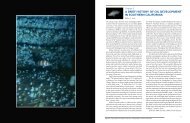checklist (pdf) - The Love Lab - University of California, Santa Barbara
checklist (pdf) - The Love Lab - University of California, Santa Barbara
checklist (pdf) - The Love Lab - University of California, Santa Barbara
Create successful ePaper yourself
Turn your PDF publications into a flip-book with our unique Google optimized e-Paper software.
Order Elopiformes<br />
Family Elopidae —Tenpounders<br />
Elops affinis Regan, 1909. Machete or Pacific Ladyfish. To 91.4 cm (3 ft) TL (Miller and Lea 1972). Mandalay<br />
Beach, southern <strong>California</strong> (Eschmeyer and Herald 1983) to Talara, Peru (Chirichigno and Vélez 1998),<br />
including Gulf <strong>of</strong> <strong>California</strong> (Whitehead and Rodriguez-Sanchez in Fischer et al. 1995). Shallow marine<br />
waters, frequently enters fresh water (Allen and Robertson 1994) to 10 m (33 ft; Robertson and Allen 2002).<br />
Order Albuliformes<br />
Family Albulidae — Bonefishes<br />
Albula sp. Cortez Bonefish. To about 36 cm (14.4 in) SL. San Francisco, northern <strong>California</strong>, along west coast<br />
<strong>of</strong> Baja <strong>California</strong>, and into the Gulf <strong>of</strong> <strong>California</strong>. Southern range limit is unknown. Nearshore waters.<br />
Previously referred to as Albula vulpes. Work by Pfeiler (1996) and Pfeiler et al. (2002) suggests there are<br />
a number <strong>of</strong> undescribed bonefish species in the eastern Pacific. A species referred to as “Albula sp. A” by<br />
Pfeiler and coworkers is found along the Pacific coast <strong>of</strong> North America and in the Gulf <strong>of</strong> <strong>California</strong>.<br />
See Nelson et al. (2004) for discussion <strong>of</strong> molecular studies and nomenclature.<br />
Dixonina sp. Shafted Bonefish. A poorly described member <strong>of</strong> this genus appears to live along the southern<br />
west coast <strong>of</strong> Baja <strong>California</strong> and in the southern Gulf <strong>of</strong> <strong>California</strong> (Pfeiler 1996).<br />
Family Halosauridae — Halosaurs<br />
Unidentified Aldrovandia. Two halosaurs, as yet unidentified to species, were caught in 2004 <strong>of</strong>f the west<br />
coast <strong>of</strong> the Queen Charlotte Islands, British Columbia, including one very near the Alaska border (G. E.<br />
Gillespie, pers. comm. to C.W.M.). Halosaurs pursue a benthopelagic lifestyle in deep waters, usually<br />
over continental slopes. Perhaps the most likely species is: Aldrovandia affinis (Günther, 1977). Gilbert’s<br />
Halosaur. To about 55 cm (21.7 in) TL (Sulak in Quéro et al. 1990). Circumglobal, including cold waters<br />
<strong>of</strong>f New England in the western North Atlantic (Moore et al. 2003); in North Pacific, <strong>of</strong>f the Korean<br />
Peninsula (Youn 2002) and Japan (Shinohara et al. 1996, 2001; Nakabo 2002). Benthopelagic, about<br />
730–2,200 m (2,395–7,218 ft; Sulak in Quéro et al. 1990). Another possiblity is Aldrovandia phalacra<br />
(Vaillant, 1888), also probably circumglobal including cold waters, such as <strong>of</strong>f Greenland (Okamura and<br />
Takahashi in Okamura et al. 1995), and including the North Pacific Ocean <strong>of</strong>f Hawaii (Sulak in Quéro<br />
et al. 1990).<br />
Family Notacanthidae —Spiny Eels<br />
Notacanthus chemnitzii Bloch, 1788. Snubnosed Spiny Eel. To more than 135 cm (54 in) TL (Mecklenburg<br />
et al. 2002). Probably circumglobal; Greenland (Okamura and Takahashi in Okamura et al. 1995); Japan<br />
(Yabe in Amaoka et al. 1983); Sea <strong>of</strong> Okhotsk (Orlov 1998); near Alaska <strong>of</strong>f Dixon Entrance, northern<br />
British Columbia (G. E. Gillespie, pers. comm. to C W. M.); Oregon (Peden 1976); Point Sur and edge<br />
<strong>of</strong> Monterey Submarine Canyon, central <strong>California</strong> (Lea and Rosenblatt 1987) to Chile (Pequeño 1989).<br />
Benthopelagic, at depths <strong>of</strong> 128–3,285 m (413–10,775 ft) (min.: McDowell 1973; max.: Yabe in Amaoka<br />
et al. 1983); usually taken at the greater depths (Mecklenburg et al. 2002).<br />
Polyacanthonotus challengeri (Vaillant, 1888). Longnose Tapirfish. To about 60 cm (23.6 in) TL (Gon in Gon<br />
and Heemstra 1990). Circumglobal, predominantly antitropical, on the continental rise; northern Japan<br />
Sea <strong>of</strong>f Hokkaido (Yabe in Amaoka et al. 1983) and western North Pacific <strong>of</strong>f southern Honshu (Crabtree<br />
et al. 1985) to southern Bering Sea (Mecklenburg et al. 2002) to Cape Falcon, Oregon (Stein and Butler<br />
1971). Benthopelagic, at 830–3,753 m (2,723–12,313 ft) (min.: ZIN 45805; max.: Sulak et al. 1984).<br />
16




